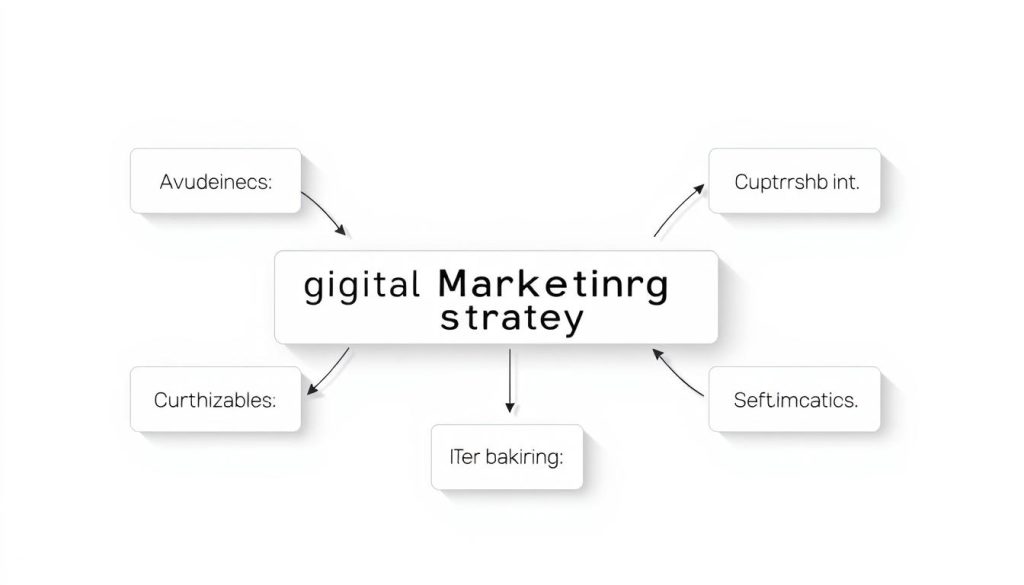Are you ready to unlock the secrets of digital content creation and revolutionize your digital marketing strategy? As technology continues to evolve, the landscape of digital content is changing at a rapid pace.
The way we consume and interact with digital content is shifting, and content creators must adapt to these changes to remain relevant. With new opportunities emerging to engage audiences and deliver high-quality content, the future looks bright for those who are willing to innovate.
The key to success lies in understanding the current state of digital content creation and being aware of the trends that are shaping the industry.
Key Takeaways
Table of Contents
- Understanding the current state of digital content creation is crucial for success.
- Staying abreast of industry trends is essential for creating future-proof content.
- A well-planned digital marketing strategy is vital for engaging your target audience.
- Adapting to technological advancements is key to remaining relevant.
- Innovation is the driving force behind successful digital content creation.
Current Landscape of Digital Content Creation
The digital content creation landscape is rapidly evolving, driven by technological advancements and changing consumer behaviors. As a result, content creators must adapt to new trends and tools to remain relevant.
The evolution of content creation in the digital age has been marked by significant shifts. Interactive and immersive content have become increasingly popular, allowing creators to engage their audiences more effectively. According to a recent study, interactive content can increase user engagement by up to 20%.
Evolution of Content Creation in the Digital Age
The rise of digital platforms has transformed the way content is created and consumed. New formats and distribution channels have emerged, offering creators more opportunities to reach their target audiences. As noted by industry expert, “The future of content creation lies in its ability to adapt to new technologies and consumer preferences.”
Key Challenges Content Creators Face Today
Despite the opportunities, content creators face several challenges, including staying up-to-date with the latest content creation trends and content creation tools. Measuring the effectiveness of their content is also a significant concern. Creators must leverage analytics tools to understand their audience and adjust their strategies accordingly.
The Future of Digital Content Creation: Key Trends
The digital content creation sphere is undergoing a significant transformation driven by innovative technologies and shifting audience preferences. This evolution is giving rise to new trends that are redefining the way content is created, consumed, and interacted with.
AI-Powered Content Generation Tools
AI-powered content generation tools are becoming increasingly popular among content creators. These tools leverage artificial intelligence to produce high-quality content at scale, significantly reducing the time and effort required for content creation. For instance, AI can be used to generate blog posts, social media updates, and even entire books. While some may argue that AI-generated content lacks the human touch, it has the potential to enhance creativity by freeing up time for more strategic and creative tasks.
Interactive and Immersive Content Experiences
The rise of interactive and immersive content experiences is another key trend. Technologies such as Augmented Reality (AR) and Virtual Reality (VR) are enabling content creators to craft engaging and memorable experiences for their audiences. Interactive content, such as quizzes, polls, and interactive videos, encourages audience participation, leading to higher engagement rates and a more immersive brand experience.
User-Generated Content Strategies
User-generated content (UGC) strategies are gaining traction as brands recognize the value of leveraging their audiences’ creativity. UGC campaigns encourage users to create and share content related to a brand or product, providing authentic and relatable content that resonates with potential customers. This approach not only fosters community engagement but also serves as a powerful marketing tool, as consumers are more likely to trust content created by their peers.
By embracing these trends, content creators can stay ahead of the curve and deliver content that meets the evolving needs and expectations of their audiences.
Essential Tools and Platforms for Modern Content Creators
Modern content creators require a robust toolkit to manage, create, and distribute content effectively. The digital landscape is replete with various tools and platforms designed to streamline content creation, enhance productivity, and measure performance.
Content Creation Platforms and Management Systems
Content creation platforms and management systems are crucial for organizing and scheduling content. Tools like HubSpot and WordPress offer comprehensive solutions for content management, allowing creators to plan, publish, and analyze content from a single dashboard.
These platforms often include features such as content calendars, collaboration tools, and SEO optimization suggestions, making it easier for creators to manage their content workflow efficiently.
Creative Design and Editing Software
High-quality content often requires visually appealing graphics and videos. Creative design and editing software like Adobe Creative Cloud provides a suite of tools including Photoshop, Premiere Pro, and After Effects, enabling creators to produce professional-grade content.
These tools offer advanced features such as AI-powered editing, color grading, and special effects, which can significantly enhance the quality of the content.
Analytics and Performance Tracking Tools
Understanding how content performs is vital for making informed decisions. Analytics tools like Google Analytics and SEMrush provide insights into content performance, audience engagement, and traffic sources.
By analyzing these metrics, creators can refine their content strategy, identify areas for improvement, and measure the effectiveness of their content distribution channels.
| Tool Category | Examples | Key Features |
|---|---|---|
| Content Management | HubSpot, WordPress | Content calendars, SEO optimization, collaboration tools |
| Creative Design | Adobe Creative Cloud | AI-powered editing, color grading, special effects |
| Analytics | Google Analytics, SEMrush | Traffic analysis, audience engagement, performance tracking |
“The right tools can make all the difference in content creation, enabling creators to produce high-quality content that resonates with their audience.”
Step-by-Step Guide to Creating Future-Proof Content
As the digital landscape continues to evolve, creating content that resonates with your target audience is more important than ever. To achieve this, you need to have a clear understanding of your audience and a well-planned content strategy. In this section, we will provide a step-by-step guide to creating future-proof content that drives results.
Step 1: Identify Your Target Audience and Content Goals
Understanding your target audience is crucial to creating content that resonates with them. You need to identify their needs, preferences, and pain points to develop a content strategy that meets their expectations. Conducting thorough audience research will help you create buyer personas that guide your content creation process.
To identify your target audience, you can use various tools such as Google Analytics, social media insights, and customer surveys. Once you have a clear understanding of your audience, you can set specific, measurable, achievable, relevant, and time-bound (SMART) content goals.
Step 2: Develop a Digital Marketing Strategy Framework
A well-planned digital marketing strategy framework is essential to creating future-proof content. This framework should include content creation, distribution, and promotion techniques that align with your business goals. You need to identify the most effective channels to reach your target audience and create content that resonates with them.
A digital marketing strategy framework should also include metrics to measure the success of your content. This will help you track the performance of your content and make data-driven decisions to improve it.

Step 3: Implement a Streamlined Content Creation Process
A streamlined content creation process is crucial to creating high-quality, engaging content that resonates with your target audience. This process should include content planning, creation, review, and publication. You need to have a clear understanding of your content calendar and ensure that it aligns with your business goals.
To implement a streamlined content creation process, you can use various tools such as content management systems (CMS), project management tools, and collaboration software.
Step 4: Master Distribution and Promotion Techniques
Creating high-quality content is not enough; you need to ensure that it reaches your target audience. This requires effective distribution and promotion techniques that align with your business goals. You need to identify the most effective channels to distribute your content, such as social media, email newsletters, or paid advertising.
| Distribution Channel | Promotion Technique | Metrics to Measure Success |
|---|---|---|
| Social Media | Paid Advertising, Influencer Marketing | Engagement Rate, Reach, Conversions |
| Email Newsletters | Personalization, Segmentation | Open Rate, Click-through Rate, Conversions |
| Paid Advertising | Targeted Advertising, Retargeting | Click-through Rate, Conversions, Return on Ad Spend |
By following these steps, you can create future-proof content that drives results for your business. Remember to continuously monitor and adjust your content strategy to ensure it remains effective in the ever-changing digital landscape.
“Content is king, but distribution is queen, and she wears the pants.” –
Content Creation Best Practices Across Different Formats
As digital content continues to evolve, understanding the best practices across different formats is crucial for creators. The digital landscape is diverse, with various formats demanding unique approaches to engage audiences effectively.
Video Content Creation Techniques
Video content remains a powerful tool for engaging audiences. To maximize its potential, creators must consider the type of video content that best suits their goals.
Short-Form vs. Long-Form Video Content
Short-form videos are ideal for capturing attention quickly, making them perfect for social media platforms. Long-form content, on the other hand, is better suited for in-depth storytelling and educational content.
Video Optimization for Multiple Platforms
Optimizing video content for different platforms is crucial. This includes adjusting video length, captions, and thumbnails to suit each platform’s unique requirements.
Social Media Content Creation Strategies
Social media platforms require tailored content strategies to effectively engage their unique user bases.
Platform-Specific Content Approaches
Understanding the nuances of each social media platform is key. For example, Instagram favors visually appealing content, while Twitter prioritizes concise, timely updates.
Building Engagement Through Interactive Content
Interactive content, such as polls and quizzes, can significantly boost engagement on social media platforms.
| Platform | Content Type | Engagement Strategy |
|---|---|---|
| Visual Content | Use Stories and Reels | |
| Text-based Content | Utilize Hashtags and Polls | |
| Mixed Media | Leverage Groups and Live Streaming |
Emerging Content Formats: Podcasts, AR, and VR
Emerging formats like podcasts, Augmented Reality (AR), and Virtual Reality (VR) offer new avenues for content creators. Podcasts provide an intimate, auditory experience, while AR and VR enable immersive interactions.
By embracing these diverse formats and tailoring strategies to each, creators can stay ahead of the curve and captivate their audiences more effectively.
Conclusion: Preparing for Success in the Evolving Content Landscape
The future of digital content creation is rapidly evolving, driven by emerging trends and technologies. To stay ahead, content creators must be adaptable and willing to leverage the latest tools and platforms.
By understanding the current landscape and key challenges, creators can develop a strategic approach to content creation. This involves identifying target audiences, implementing effective distribution and promotion techniques, and mastering best practices across different formats.
As the digital landscape continues to shift, staying informed about content creation trends is crucial. By doing so, creators can position themselves for success and thrive in an ever-changing environment. The future of digital content creation is bright, and those who are prepared will be well on their way to achieving their goals.
FAQ
What are the key trends shaping the future of digital content creation?
The future of digital content creation is being shaped by several key trends, including AI-powered content generation tools, interactive and immersive content experiences, and user-generated content strategies.
How can I stay up-to-date with the latest content creation trends and technologies?
To stay current, follow industry leaders, attend conferences, and participate in online forums focused on digital content creation, such as those discussing AI in content creation and video content creation.
What are the essential tools for modern content creators?
Essential tools include content creation platforms and management systems, creative design and editing software, and analytics and performance tracking tools, which help streamline the content creation process and measure its effectiveness.
How do I create a digital marketing strategy framework for my content?
To develop a digital marketing strategy framework, identify your target audience and content goals, and then plan your content creation and distribution accordingly, leveraging social media content creation strategies and other relevant tactics.
What are the best practices for creating engaging video content?
Best practices for video content creation include understanding the differences between short-form and long-form content, optimizing for multiple platforms, and using techniques such as interactive content to build engagement.
How can I leverage user-generated content to enhance my content strategy?
To leverage user-generated content, encourage your audience to create content related to your brand, and then showcase this content across your marketing channels, fostering a sense of community and authenticity.
What role do emerging content formats like podcasts, AR, and VR play in the future of digital content creation?
Emerging formats like podcasts, AR, and VR offer new opportunities for engagement and immersion, allowing content creators to innovate and stay ahead of the curve in the evolving digital landscape.


